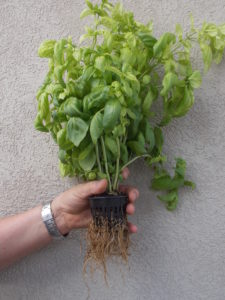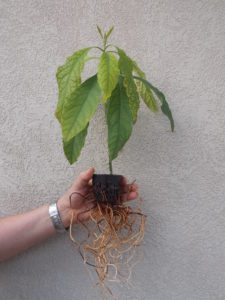Your New Farming Partner: Fish
In the Summer 2014 issue of Small Farm Quarterly, we discussed the worldwide phenomenon known as Aquaponics. Getting started isn’t as complicated as you might think. It’s simple; you start with a fish tank, some fish and starter plants. Your new farming partner swims, eats, generates a lot of waste and does all the work for you. The only thing you’ll need to do is feed your new farming partner and watch your plants grow.
I tried an experiment to see if it’s really that easy. I filled the fish tank with tap water, let it cycle for one day and then added fish and plants and waited to see what would happen. The plan was to pump the water from the fish tank into the plants’ soilless grow bed. The grow bed can be horizontal or vertical in design. I chose the horizontal design for the experiment. I filtered the water through the plants, plant bed medium and it returned cleaned to the fish tank. The nutrients rich water (fish waste) is in constant contact with the plants throughout the cycling of the water.
From every article and book I’ve read, I pretty much did everything wrong. I created an experiment destined to fail. Thirty days later I was surprised to find plants growing and fish swimming; my Aquaponic garden was thriving! Why didn’t it fail? That’s the big question. You see an Aquaponic growing system is a closed ecosystem, and if left to its own design, it will do everything in its power to succeed to its limits. As the months passed the system did start to fail. The pumps got clogged, hoses had algae build-up that reduced flow by 50%, fish were stressed and some died, plants started to wilt and the system was shutting-down.
Easy Come, Easy Go
Aquaponic systems are easy to start, and just as easy to fail if you do nothing. These systems do require maintenance, repairs, adjustment, and a learning curve. If you have a small system working it doesn’t necessarily mean that scaling up to a larger system will be successful. You will, however, have a better chance of success from the knowledge gained by operating that smaller system. As an example: pump failure on my small aquaponic system cost about $30 to repair, whereas the pump on my larger commercial system cost about $300. Also, I only have about a 3 hour window to replace that pump before I start losing fish stock and vegetables.

The healthy root system shown here was established in my experimental Aquaponic system in just 30 days from a 4 inch starter basil plant.
The Basic Components
Fish. You’ll have to decide on what type of fish you want to farm. The four most common fish used in Aquaponics systems are; trout, cat fish, carp, and tilapia. These farming fish stock would be for food or reselling. You could also farm Koi or pool size goldfish. These are mostly for resale as non-food. On average in a healthy fish tank it takes about 7-12 months to grow fish to harvest (food) size. Each one of these fish species does have its own required growing environment, so choice could be limited depending upon where you live. Fish are usually purchased as fingerlings about 2-3inches in length from hatcheries. Fish can also be purchased online. In a starting system, figure about 1 fish per 2-3 gallon of water to be safe.
Holding Tank. The fish tank can be an aquarium, plastic container, kiddie swimming pool, or an IBC container or anything that can hold water. Be sure containers are food grade safe for both fish tank and grow beds.
Grow Beds. I prefer vertical growing techniques because of their space saving design. But you can also grow horizontal as well as vertical in round PVC pipe, square plastic fence post, or a flat tray grow bed. There are plenty of options. They are usually dictated by what you are growing and where.
Pumps. Pumps are determined by how much water volume you have and need to move. If your fish tank is 100 gallons you will want a pump that can recycle the water once (even better, twice) every hour. Pumps are rated in GPH (gallons per hour).
Air Bubbler. The air bubbler is simply a continuous running air pump that supplies much needed oxygen to your fish and plants through a bubbler stone placed in the fish tank.
Tank Heater. Depending on the fish species and season of year, you may also need a tank heater. They’re very straight forward; heater selection is based on the gallons of water you’re trying to heat.
Daily Operation
The Aquaponic system is a closed loop system. Water is recycled using 70% less water than traditional soil based systems. Because plants are fed constantly through a recycled system they become 4-6 times more productive and grow to maturity 2-3 times faster than conventional soil systems. Aquaponic fish and plants require a neutral PH for optimum health. System PH, dissolved oxygen levels and water hardness also need to be measured daily or weekly. These measurements are indicators of water and tank health, with PH and dissolved oxygen being the most important considerations. Measurements can be done with electronic metering or inexpensive disposable test strips. Quality organic fish food should also be used, if fish are healthy plants stay healthy. Prepared commercial fish food should be purchased as certified organic. If you use an Aquaponic system for growing, all produce and fish stock in your system would have an organic classification.

This is a 2-month old avocado tree grown in an Aquaponic system from an avocado nut. Again, notice the healthy root system. Avocados seem to love the Aquaponics environment.
Just about anything can be grown aquaponicly. You are not limited to vegetables and herbs. I have grown avocados, pineapples, potatoes, carrots and house plants. I’m always experimenting. You can even grow from seed; it’s a little tricky but can be done.
Lessons Learned
I have spent a great amount of time testing, operating, reading and watching tons of videos on the subject of Aquaponics. Here’s what I have found. Keep it simple, start small (less than 100 gallons). Try your system for one complete growing season. Eat everything you grow, take plenty of notes and learn from your mistakes.



Edward – I have designed and am about to build my first Back Yard Aquaponic System and found your site quite informative.
I’m not sure what if any the limitations are for this comment section so I will send an email later. Go to http://www.evergreenfarmzs.org to get an idea of where I’m heading. At the time that site went up I was working with a Hydroponics guy in Canada. I changed course but he did not.
Fred Howard
chosenrescue82@gmail.com
Greenville, Tx.
This is such an AMAZING idea! The way you explained each point with necessary details is really commendable.
This is amazing, I first heard about this idea from a biology professor who used tilapia in his system. I have been fascinated by the idea ever since and have been doing research so when I purchase my home I can have my own. Do you have any recommendations regarding tank size vs the number of plants you are able to grow?